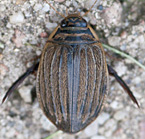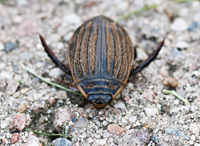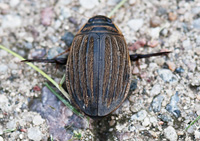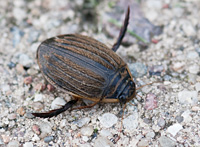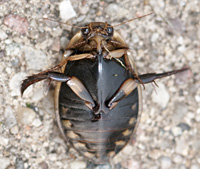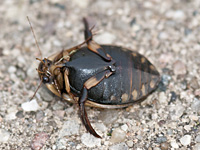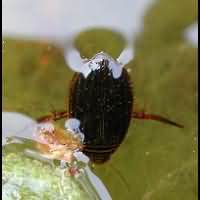[All pictures of garden wildlife on this page are thumbnails. Click on any thumbnail for a large format to be displayed.]

Grooved Diving Beetle (Acilius sulcatus)
| Taxonomy | ||||||
|---|---|---|---|---|---|---|
| Kingdom: | Phylum: | Class: | Order: | Family: | Genus: | Species: |
| Animalia | Arthropoda | Insecta | Coleoptera | Dytiscidae | Acilius | A. sulcatus |
This species is called the Grooved Diving Beetle although the name is quite misleading. It suggests certain distinguishing features to pay attention to but it turns out that only the female has grooved shields. These groves are filled with surprisingly lush hair. The purpuse of it becomes clear during mating seasons in spring and autumn when the male holds to female's hair. Hence the male Grooved Diving Beetle does not need the discs on the front legs like - for example - the Water Tiger. The male himself has smooth shields and is often difficult to identify since it resembles a number of other diving beetles. Of the most common water beetle species A.sulcatus is the fasterst swimmer.
Acilius sulcatus reaches some 16 to 18 mm in size and it is not capable of biting humans. The larvae are rather small and are easily identifiable by their relatively long neck.
Usually you find this beetle in water and it can easily be identified by 'peddling' movement of its legs (see the bottom photo). To my total astonishment one day I found the beetle laying upside down on the garden terrace at a quite long distance from any pond or stream. So I then cautiously took a couple of photos which you see in the first six photos on this page. Only later I found out that the Grooved Diving Beetles can actually fly so it is not uncommon to find them far away from any water. They are not restricted to specific pond or stream and thus sometimes on the move.
They feed on small invertebrate and vertebrate prey, such as Water Fleas and larvae of mosquitoes. The beetle overwinters in water that is deep enough not to freeze or dry out. Until the water freezes over it remains active both day and night.
The Grooved Diving Beetle is also known as the Lesser Diving Beetle.

© Copyright 1998-2024 gardensafari.net (Hania Berdys)

 English / engels
English / engels  Dutch / nederlands
Dutch / nederlands